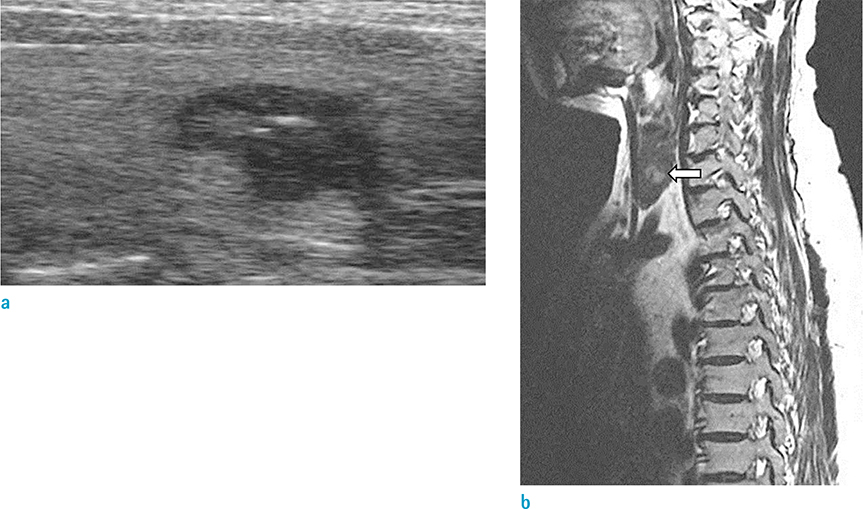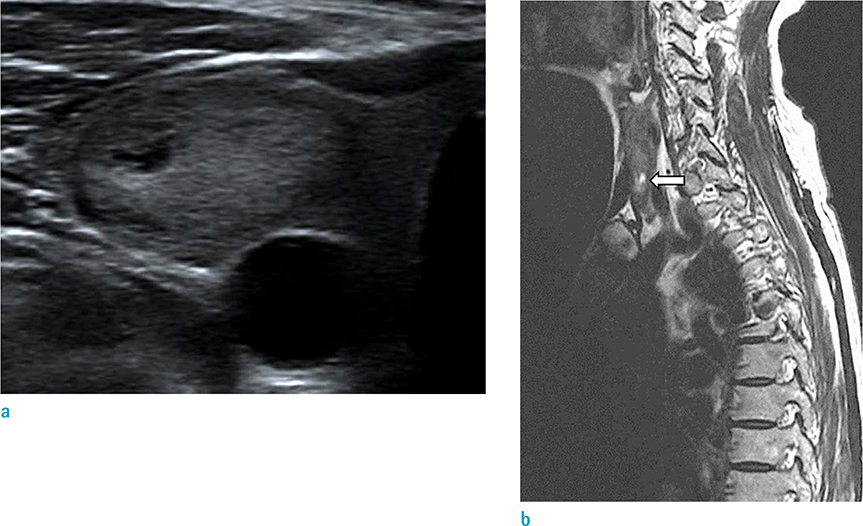Investig Magn Reson Imaging.
2015 Dec;19(4):224-230. 10.13104/imri.2015.19.4.224.
Should We Recommend Ultrasonography for an Incidental Thyroid Nodule on Additional Cervicothoracic Sagittal T2-Weighted Image of Lumbar Spine MRI?
- Affiliations
-
- 1Department of Radiology, Research Institute of Radiological Science, Medical Convergence Research Institute, and Severance Biomedical Science Institute, Yonsei University College of Medicine, Seoul, Korea.
- 2Department of Orthopedic Surgery, Yonsei University College of Medicine, Seoul, Korea. parkjo@yuhs.ac
- KMID: 2151769
- DOI: http://doi.org/10.13104/imri.2015.19.4.224
Abstract
- PURPOSE
To determine whether we should recommend ultrasonography (US) for an incidental thyroid nodule identified by additional cervicothoracic sagittal T2-weighted image (C-T sag T2WI) of lumbar spine magnetic resonance imaging (MRI).
MATERIALS AND METHODS
A retrospective study of 61 patients who underwent both lumbar spine MRI and thyroid US between December 2011 and April 2015 was conducted. For all US-found thyroid nodules > 1 cm, investigators evaluated whether there was any correlation between thyroid nodule detectability by C-T sag T2WI and US features such as echogenicity, composition, or suspicion of malignancy.
RESULTS
Solid hypoechoic (2/4; 50%) or mixed echoic nodules (4/8; 50%) appeared to be found relatively more easily by C-T sag T2WI than more benign-looking solid isoechoic (1/4; 25%) or spongiform nodules (0/6; 0%). Among six nodules with ultrasonographic suspicion for malignancy, only one nodule was detected by C-T sag T2WI.
CONCLUSION
If an incidental thyroid nodule is seen by C-T sag T2WI, it would be better to recommend thyroid US for identifying malignancy.
MeSH Terms
Figure
Reference
-
1. Kamath S, Jain N, Goyal N, Mansour R, Mukherjee K. Incidental findings on MRI of the spine. Clin Radiol. 2009; 64:353–361.2. Grady AT, Sosa JA, Tanpitukpongse TP, Choudhury KR, Gupta RT, Hoang JK. Radiology reports for incidental thyroid nodules on CT and MRI: high variability across subspecialties. AJNR Am J Neuroradiol. 2015; 36:397–402.3. Nam-Goong IS, Kim HY, Gong G, et al. Ultrasonography-guided fine-needle aspiration of thyroid incidentaloma: correlation with pathological findings. Clin Endocrinol (Oxf). 2004; 60:21–28.4. Kang HW, No JH, Chung JH, et al. Prevalence, clinical and ultrasonographic characteristics of thyroid incidentalomas. Thyroid. 2004; 14:29–33.5. Kim K, Emoto N, Mishina M, et al. Incidental detection of thyroid nodules at magnetic resonance imaging of the cervical spine. Neurol Med Chir (Tokyo). 2013; 53:77–81.6. Seo J, Park SY, Lee JW, Lee GY, Kang HS. The value of additional cervicothoracic spine sagittal T2-weighted images included in routine lumbar spine MR imaging. J Korean Soc Magn Reson Med. 2013; 17:91–100.7. Cooper DS, Doherty GM, Haugen BR, et al. Revised American Thyroid Association management guidelines for patients with thyroid nodules and differentiated thyroid cancer: the American Thyroid Association (ATA) guidelines taskforce on thyroid nodules and differentiated thyroid cancer. Thyroid. 2009; 19:1167–1214.8. Kwak JY, Han KH, Yoon JH, et al. Thyroid imaging reporting and data system for US features of nodules: a step in establishing better stratification of cancer risk. Radiology. 2011; 260:892–899.9. Serpell J. Management guidelines for patients with thyroid nodules. ANZ J Surg. 2010; 80:765–766.10. Cooper DS, Doherty GM, Haugen BR, et al. Management guidelines for patients with thyroid nodules and differentiated thyroid cancer. Thyroid. 2006; 16:109–142.11. Kamran SC, Marqusee E, Kim MI, et al. Thyroid nodule size and prediction of cancer. J Clin Endocrinol Metab. 2013; 98:564–570.12. Wong KT, Ahuja AT. Ultrasound of thyroid cancer. Cancer Imaging. 2005; 5:157–166.13. Moon WJ, Jung SL, Lee JH, et al. Benign and malignant thyroid nodules: US differentiation--multicenter retrospective study. Radiology. 2008; 247:762–770.14. Lee MJ, Kim EK, Kwak JY, Kim MJ. Partially cystic thyroid nodules on ultrasound: probability of malignancy and sonographic differentiation. Thyroid. 2009; 19:341–346.15. Bellantone R, Lombardi CP, Raffaelli M, et al. Management of cystic or predominantly cystic thyroid nodules: the role of ultrasound-guided fine-needle aspiration biopsy. Thyroid. 2004; 14:43–47.
- Full Text Links
- Actions
-
Cited
- CITED
-
- Close
- Share
- Similar articles
-
- The Value of Additional Cervicothoracic Spine Sagittal T2-weighted Images Included in Routine Lumbar Spine MR Imaging
- Incorporation of Whole Spine Screening in Magnetic Resonance Imaging Protocols for Low Back Pain: A Valuable Addition
- Clinical Utility of Limited T2-Weighted-Only Lumbar Spine MRI in Pain Intervention Clinics
- Value of Additional Cervicothoracic Sagittal T2-Weighted Images in Elderly Patients with Symptoms Suggestive of Lumbar Spinal Stenosis
- Coexisting Spine Lesions on Whole Spine T2 Sagittal MRI in Evaluating Spinal Degenerative Disease




